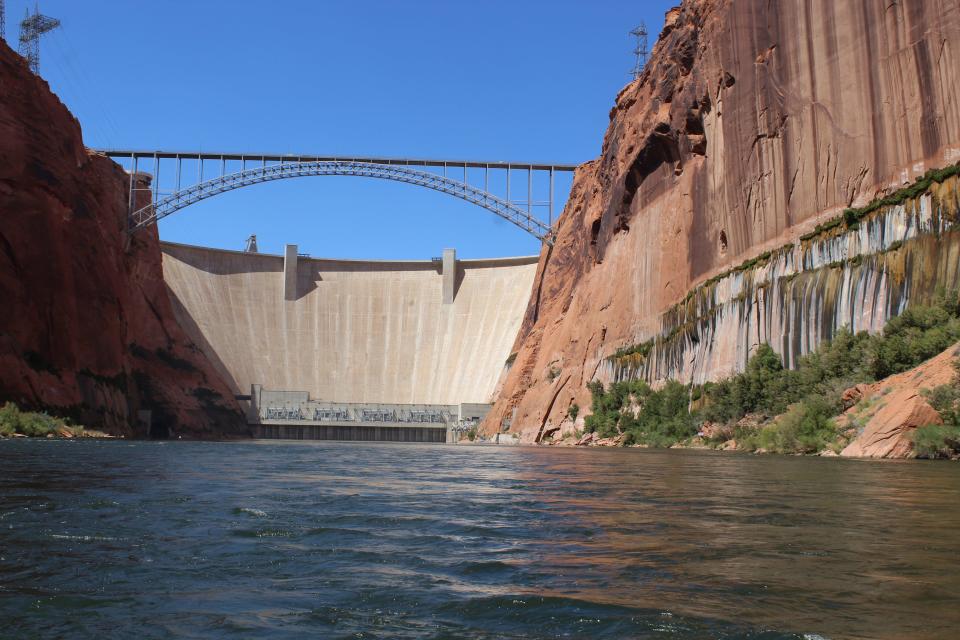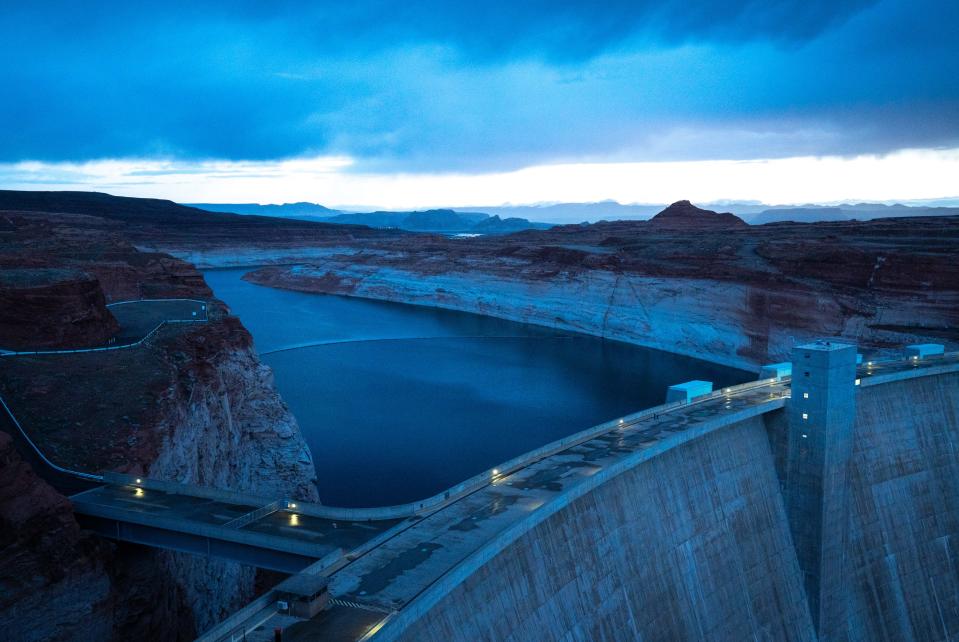Feds could alter dam flows to halt invasive bass in the Grand Canyon, protect native fish
Federal water managers will spend much of the next year developing a plan for Glen Canyon Dam operations that they hope might stem the scourge of invasive smallmouth bass that now threaten the Grand Canyon’s native fish.
Decades of drought have sunk Lake Powell’s surface near enough to the dam’s hydropower intakes that non-native bass have slipped through and begun to spawn downstream on the Colorado River. That surface layer also holds the reservoir’s warmest water, and its movement through the dam has created river conditions more suitable for the invading bass.
The U.S. Bureau of Reclamation announced it will conduct an environmental study of the costs and benefits of options to disrupt bass spawning above the river’s Lees Ferry stretch. Among the options: pulsing waves of cold water through the dam’s rarely used bypass tunnels. Those tunnels are deeper than the hydropower intakes, so they release colder water but also pass without producing electricity.
At risk is the humpback chub, a silvery fish that grows to about a foot and half if not eaten when young, and that has swum the Colorado for a few million years. A recent rebound in the Grand Canyon population moved the chub’s status from endangered to threatened, with Endangered Species Act protections still in place.
“We will continue our work to protect the river and its native species to the best of our ability as we plan our operations of the river,” Reclamation Commissioner Camille Calimlim Touton said in a written statement announcing the study of flow options. “If smallmouth bass continue to spawn and establish below Glen Canyon Dam, there will likely be negative impacts to the humpback chub and other native fish species.”

Reclamation is a dam-managing agency within the U.S. Interior Department. Earlier this year it considered options including cold releases from Glen Canyon’s bypass tunnels in a less-stringent environmental assessment intended to tackle the problem, but then determined that more than 7,000 public comments showed a more thorough study was needed.
The bureau now intends to produce an environmental impact statement and a decision in time to alter flows by next year’s early-summer spawning season.
Plans could include strategic floods during spawning season
Bass are aggressive fish eaters that have consumed many of the young chubs and other native river fish upstream of Lake Powell. They had slipped through the dam toward Grand Canyon before, but biologists only documented their having produced young below the dam beginning last year.
The National Park Service then temporarily poisoned a warm, backwater slough where the young bass were found. They repeated that treatment this August, after finding nearly 700 new bass there this spring. They also draped a mesh barrier across the mouth of the slough in hopes of keeping any survivors from entering the main river channel and swimming dozens of miles downstream toward a chub haven at the Little Colorado River confluence.

Some environmentalists and fisheries biologists have suggested strategic floods through the bypass tunnels during spawning season could make the river inhospitable to bass, while others prefer adding a more dramatic fix including an anchored fish barrier above the dam. Officials have said such a barrier would require significant engineering and will not be available in the short term.
"With the Grand Canyon’s endangered fish on the precipice of extinction, any short-term measures the Bureau of Reclamation takes to save them must include the installation of barriers to prevent invasive fish from passing through Glen Canyon Dam in the first place,” Center for Biological Diversity Southwest Director Taylor McKinnon said in an emailed statement.
Hydropower customers, including rural and tribal utilities across the West, could face higher prices if water that would otherwise pass through the dam’s turbines instead flows through the bypasses.
“We acknowledge the concerns associated with non-native fish establishment, which has been exacerbated by drought conditions,” Leslie James, Colorado River Energy Distributors Association Executive Director, told The Arizona Republic in an email. “It is important that the (Department of the Interior) and relevant state agencies implement all the tools they have available to stem this incursion, and not rely solely on dam operations.”
How the public can comment on the options
Reclamation’s Federal Register notice for the study says it will consider the same options previously discussed before officials determined they needed a more thorough study. Those options include cold shots of water through the bypasses, or a mix of cold releases and blasts of high water through the turbines to push bass off their spawning beds.
The agency also intends to consider the effects of taking no new action, or of using only releases through the hydroelectric plant. A flow regime that relies only on the hydropower intakes would not substantially alter the river’s temperature, officials have said, but could partially disrupt spawning nonetheless.
Bureau officials will further explain the options and gather public comment during webinars on Oct. 18 and Oct. 20. For more information, call the Bureau at (801) 524–3867, or email LTEMPSEIS@usbr.gov. The initial monthlong comment period will address the study’s scope, and a later 45-day comment period will follow release of a draft study and recommendation. A decision on altering flows is expected by summer.
Brandon Loomis covers environmental and climate issues for The Arizona Republic and azcentral.com. Reach him at brandon.loomis@arizonarepublic.com or follow him on X, formerly Twitter, @brandonloomis.
Environmental coverage on azcentral.com and in The Arizona Republic is supported by a grant from the Nina Mason Pulliam Charitable Trust. Sign up for AZ Climate, our weekly environment newsletter, and follow The Republic environmental reporting team at environment.azcentral.com and @azcenvironment on Facebook, Twitter and Instagram.
You can support environmental journalism in Arizona by subscribing to azcentral.com today.
This article originally appeared on Arizona Republic: Colorado River managers may alter flows to keep bass from Grand Canyon

